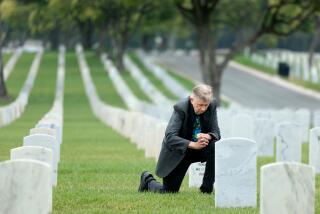Is Afghanistan Vietnam? Yes. No
- Share via
As President Kennedy pondered the risks of accidental war in the nuclear age -- a nightmare he would confront head on in the Cuban missile crisis -- he asked his senior advisors to read Barbara Tuchman’s “The Guns of August,” a narrative tracing the chain of events that led to World War I.
Today, President Obama is also reflecting on history’s lessons, asking his advisors to study the past as they help him chart America’s future course in Afghanistan. Among the “required reading” for the Obama team, it has been reported, is my book, “Lessons in Disaster,” which examines how one of the architects of the Vietnam War, McGeorge Bundy, came to renounce America’s entanglement in that tragic conflict and struggled to draw insight from it “to help us do better in the world ahead.”
As Obama weighs the risks of escalating the U.S. commitment in Afghanistan, what can a new commander in chief learn from the disaster of Vietnam?
The president is said to believe the threats posed by the two wars are starkly different. The Vietnamese communists were passionately determined to unify their country; Al Qaeda, in contrast, is dedicated to America’s destruction. Our former adversary, North Vietnam, represented little of strategic importance. Our quest in Afghanistan, on the other hand, is entwined with the interests of our ally, Pakistan, a nuclear nation and a crucial security interest of the United States.
The two conflicts nonetheless share some compelling parallels. Vietnam has never been successfully dominated by foreign powers, defeating China, France, Japan and the United States. Afghanistan, similarly, has earned its reputation as the “graveyard of empires” for subverting the imperial ambitions of Alexander the Great, the British and the Soviet Union.
During Kennedy’s presidency, South Vietnam was ruled by Ngo Dinh Diem, a corrupt autocrat who came to power by rigging a plebiscite and claiming 99% of the vote. In Afghanistan, President Hamid Karzai -- widely perceived as corrupt and illegitimate -- has managed to retain power after an August election in which about 1 million ballots were found to be fraudulent.
In Vietnam, the insurgency in the south received continuous support and sanctuary from its sponsors just across the border in North Vietnam, fortified through the Ho Chi Minh Trail. Today, many Al Qaeda operatives who used to operate from Afghanistan are believed to have taken refuge across the porous border in Pakistan.
The most pronounced similarity between the two wars is in the realm of military strategy. In Afghanistan, the top commander, Army Gen. Stanley A. McChrystal, has proposed a counterinsurgency mission similar to the one employed in Vietnam -- an approach many believe is certain to fail.
As Obama prepares to make one of the most consequential decisions of his presidency, he would be well-served to answer several core questions suggested by our troubled history in Vietnam.
--
Is failure really imminent?
In 1961, Maj. Gen. Edward Lansdale reported that “Vietnam is in critical condition . . . requiring emergency treatment.” Without drastic action, he warned, the government would be overthrown in months. JFK correctly dismissed that assessment. McChrystal has predicted that without more troops and resources, the war in Afghanistan “will likely result in failure” within a year. Is his prediction of collapse justified?
--
Are current troop levels truly inadequate?
In 1961, the military requested that troops be boosted in Vietnam to give the U.S. a 15-1 numerical advantage over the Viet Cong. Kennedy refused, urging instead “the redistribution of available forces” to “make them more effective.” There are currently more than 100,000 U.S. and allied troops in Afghanistan, supplemented by 85,000 Afghan soldiers and 80,000 Afghan police. There are an estimated 25,000 Taliban insurgents. American, allied and Afghan forces thus have a more than 10-1 numerical advantage. Can Obama deploy existing resources more effectively without substantial escalation?
--
Is protecting the population the right objective in Afghanistan?
Within months of assuming office, Kennedy approved the disastrous Bay of Pigs invasion in Cuba. “Not only were our facts in error,” Kennedy later said, “but our policy was wrong, because the premises on which it was built were wrong.” That experience bred a skepticism that would later infuse his cautious decision-making about Vietnam. In Afghanistan, McChrystal has argued for a comprehensive mission of population protection across the country. Vice President Joe Biden, in contrast, has reportedly argued for a more focused counter-terrorism mission. Obama must determine who among his advisors has correctly defined the right strategic objective in a treacherous conflict.
--
Is the current strategy militarily realistic?
In 1965, Bundy insisted: “There will be time to decide our policy won’t work after we have given it a good try.” George Ball, undersecretary of State, thought that approach was folly. “We won’t get out,” he predicted. “We’ll double our bet and get lost in the rice paddies.” Reviewing Ball’s statement three decades later, Bundy conceded that Ball had been right. In Vietnam, the United States never rigorously questioned the viability of its military strategy in advance. Is counterinsurgency a viable mission in Afghanistan? Should the United States pursue a military strategy with a historically low rate of success -- one that in Vietnam proved to be open-ended in its duration, indeterminate in its goals, dependent on intangible political factors and effectively countered by the tactics of asymmetric warfare?
Although Vietnam and Afghanistan are disparate wars separated by decades and different national interests, the core questions the commander in chief must resolve remain remarkably similar. And that is why presidents like Obama study history.
More to Read
Get the L.A. Times Politics newsletter
Deeply reported insights into legislation, politics and policy from Sacramento, Washington and beyond. In your inbox twice per week.
You may occasionally receive promotional content from the Los Angeles Times.









